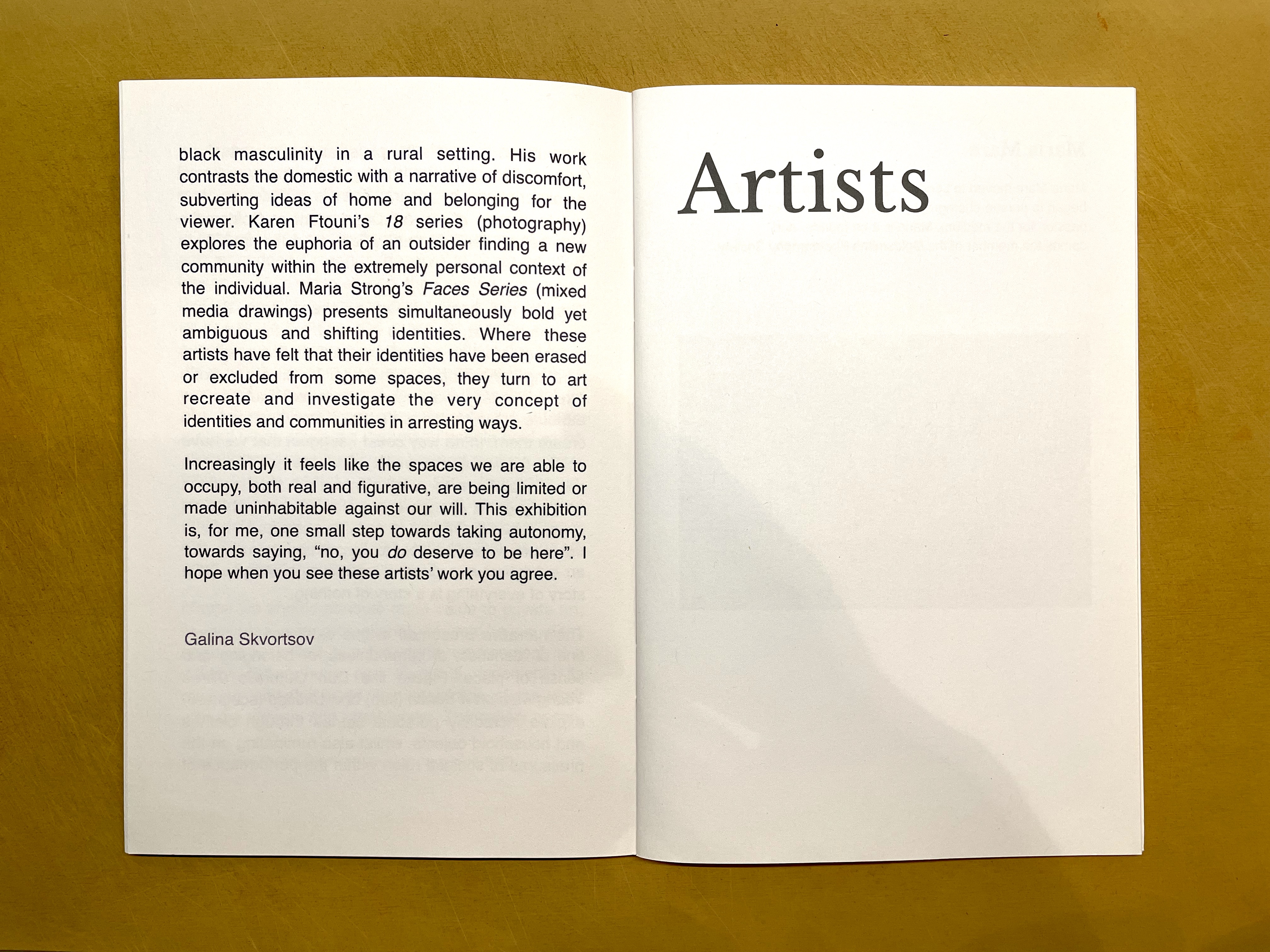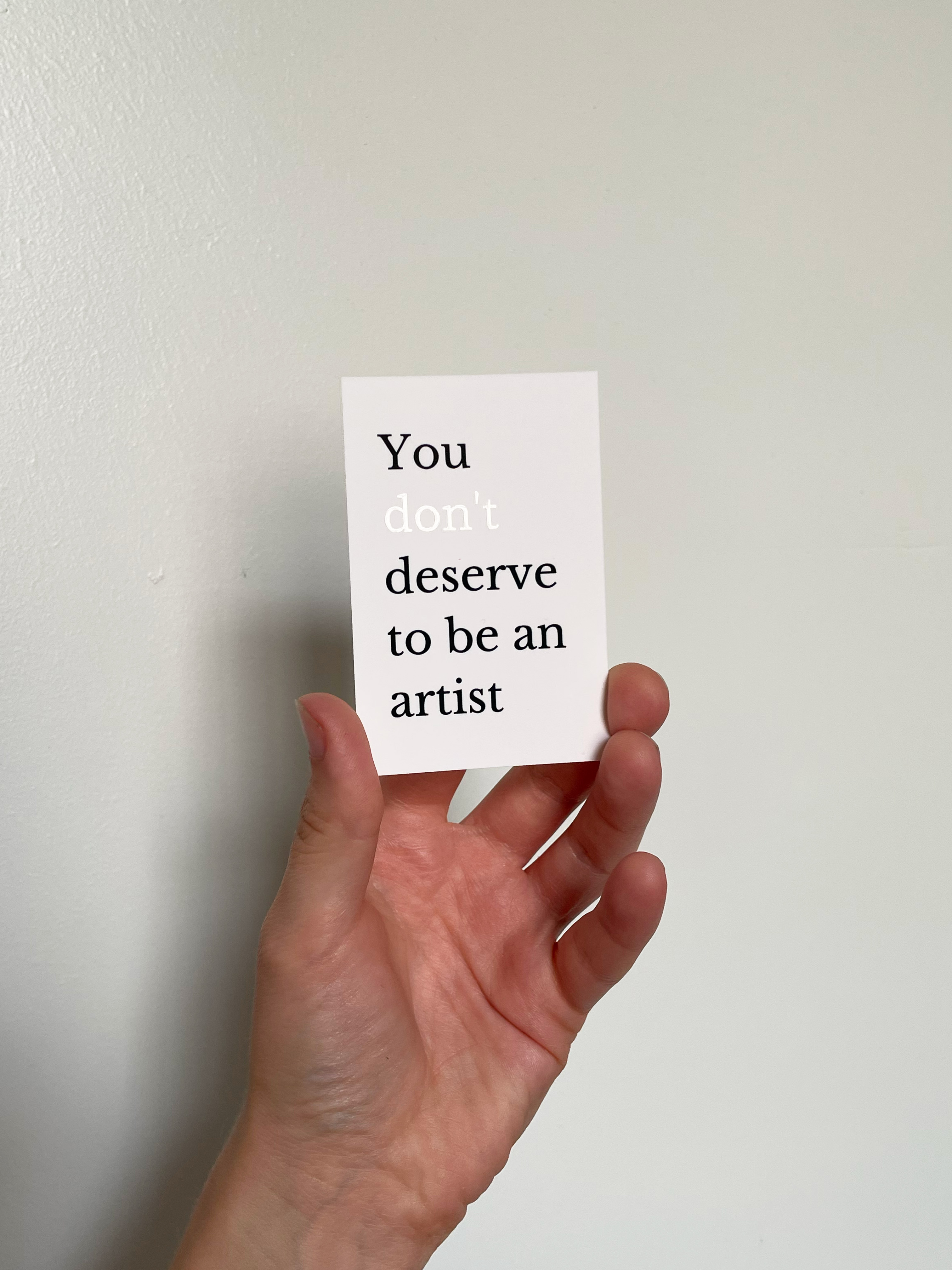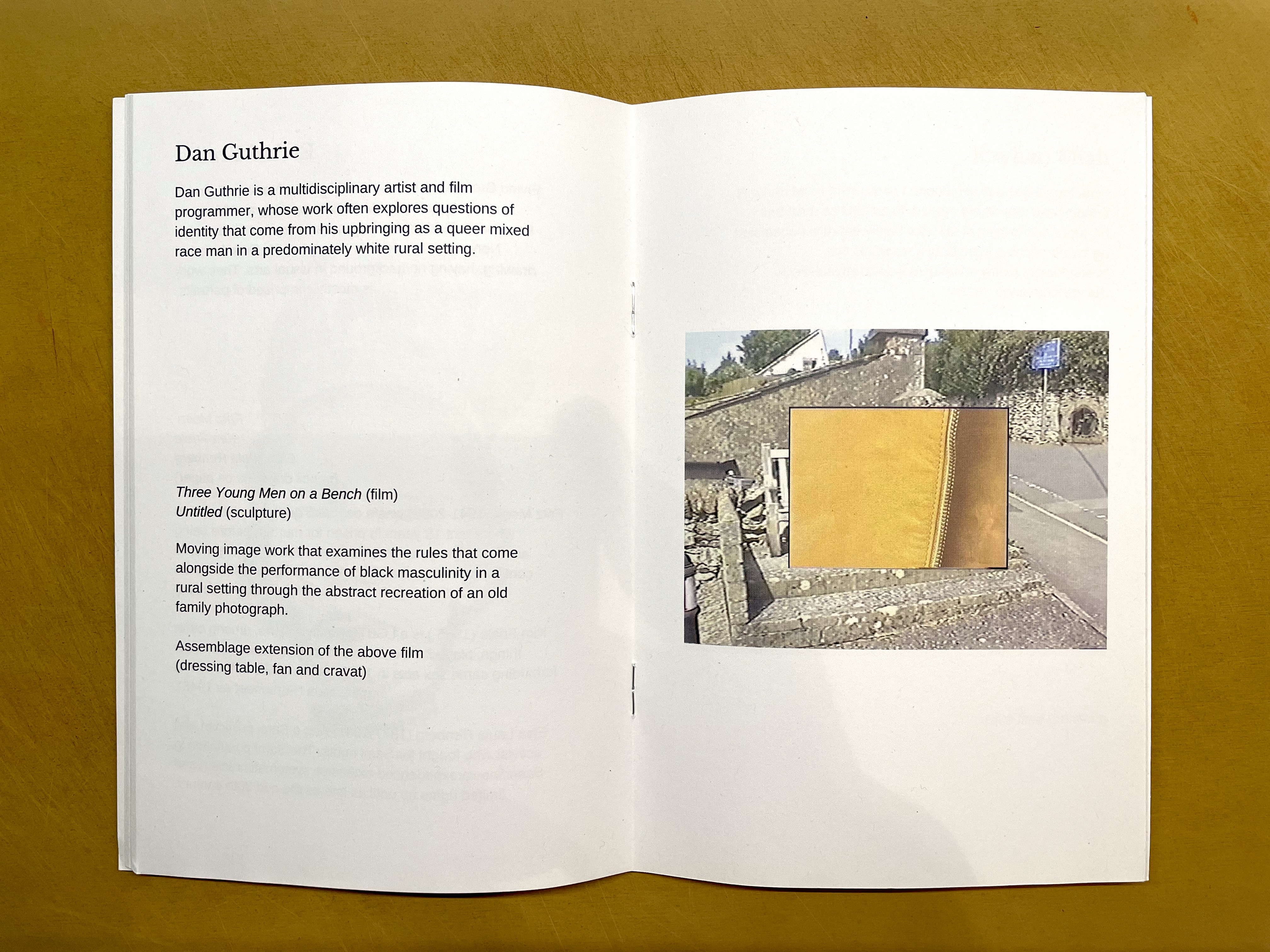1. Exhibition catalogue showing text
2. Postcard with gloss embossed half visible text (i)
3. Postcard with gloss embossed half visible text (ii)
4. Exhibition catalogue showing exhibition labels for Dan Guthrie’s film
2. Postcard with gloss embossed half visible text (i)
3. Postcard with gloss embossed half visible text (ii)
4. Exhibition catalogue showing exhibition labels for Dan Guthrie’s film
London, UK
2019
2019
You don’t deserve to be an artist
In 2019 I curated an exhibition of work exclusively by students enrolled at art school who weren’t studying a Fine Art programme.
The exhibition was created in response to a quote by Tracey Emin published in Smiths Magazine in 2016. The full exhibition text and design is below.
This exhibition was generously supported by funding from the Goldsmiths Alumni and Friends Fund.
In 2019 I curated an exhibition of work exclusively by students enrolled at art school who weren’t studying a Fine Art programme.
The exhibition was created in response to a quote by Tracey Emin published in Smiths Magazine in 2016. The full exhibition text and design is below.
This exhibition was generously supported by funding from the Goldsmiths Alumni and Friends Fund.
exhibition text
“Tough shit. You don't deserve to be an artist. You're doing another course, end of story. Don't do your course and then double. You can't.”
So if art is your hobby are you not an artist?
“Yeah, it makes you someone who enjoys recreationally painting. But you haven't had the training, you haven't been doing the discipline, you're not learning to draw, you're not learning how to paint.”
Tracey Emin, interviewed by Olivia Spring in Smiths Magazine, 2016
When I first read Olivia’s interview with Tracey Emin, it was printed facing a page of my comissioned illustrations. I was completing a degree in Creative Writing at Goldsmiths and to help pay my rent I did illustration owkr. Her words, shown across the fold from some of my drawings, stayed with me for a long time. Over the years following the article's publication, I kept returning to the discussion on who is allowed to be an artist and who is allowed to exhibit work and a lot of those conversations have informed this exhibition.
Emin's argument is easy to undermine: what about Henri Rosseau? Vincent Van Gogh? Frida Kahlo? Thornton Dial? Jean-Michel Basquiat? Ai Weiwei? Keith Haring? Grandma Moses? Yet I'm not interested in comparing these artists to Emin. It is easy and fashionable to be negative about Emin, and whilst I disagree with her statement, I am not concerned with her work here. The concern of this exhibition is the students—the artists—who are at this university, making art, and are being told by Emin in their own publication that they don't deserve to be doing so.
Goldsmiths is an unusual place. It is a university built on the aim of educating everyone; even 'men and women of the industrial, working and artisan classes’, and over the years the university has continually been home to noted creatives. Right now whilst the university encourages many interdisciplinary approaches to research, artists practicing outside the Art Department at Goldsmiths often seem invisible.
Perhaps this is in part because there are not many platforms that celebrate polymathic endeavours outside of research practice. The reality of studying here is that students are encouraged to be creative, but their creativity is often limited to certain spaces.
Lawrence Abu Hamdan is a contemporary example of the creativity which fosters in all departments at Goldsmiths. Abu Hamdan works as a researcher within the Visual Cultures department, specifically with the Forensic Architecture project, a research agency which ‘undertakes advanced spatial and media investigations into cases of human rights violations’. Abu Hamdan is also a celebrated artist and his solo exhibition was recently nominated for the Turner Prize-it has been described as an 'exploration of sound as an architectural element’, in which the artist recreates particular situations through sound and performance’. His nomination and the reaction towards Forensic Architecture certainly shows an inevitable shift in the art world towards interdisciplinary practice.
It is not only creativity but an interrogative nature towards the political landscape that seems to draw people to Goldsmiths. Students at this university have a long reputation of direct action, frequently challenging the idea of education as an elitist space. Goldsmiths' own Mark Fischer (k-punk) famously wrote that ‘emancipatory politics’ must break down what previously seemed to be universal truths in order to ‘make was previously deemed to be impossible seem attainable’. These words are painted on the wall of the Margaret Macmillan building, but are they being lived in the lecture halls?
In light of these demands for interrogation we might ask: what does it mean to 'deserve' to be an artist? If 'deserving' is a value earned, then are we suggesting that the formal education gives the artist, the art, more value? If those who make art outside of that specific group of formally educated artists don't have value, don't 'deserve' to occupy the space that those who are formally educated do, what does that tell us about how this attitude interacts with the attitude around other privileges that many people hold which allow them to continually access and exclude others from elitist, racist, misogynistic, homophobic, xenophobic, transphobic and ableist spaces? What does it say about the value of creative labour when in the hands of one person, versus the hands of another, more privileged, person?
Maybe we should attribute more value to private art, to 'hobbies' and recreational art, to craft. Maybe we don't need to assimilate into the sterile environment of a gallery. But a huge part of art is undeniable its meeting with the world, the interaction of the work with the viewer, with other works. The gallery space, the curated space, is the physical space in which art arguably becomes art, through being seen or heard or experienced by others. If art is a dialogue, then artists outside of the Fine Art course at Goldsmiths are being denied their voice in a campus-wide conversation.
There's not enough time or space here to say everything that needs to be said on the value or worth of creative labour, but suffice it to say that whilst leading on the curation of this exhibition with Taylor McGraa and Sofia Akel I was continually challenged to think about how we attribute value to things that take time and labour to create them. In no way could I suggest that we have solved this issue, and whilst I think the exhibition has given a platform to a lot of great art that wouldn't normally get a chance to exhibit like this I am very aware that we still had to limit, to exclude. I hope in the future we will be able to accommodate more. But an exhibition is a curated narrative, a story, and a story of everything is a story of nothing.
The narrative presented in this exhibition is largely one of identities, of communities, of belonging and sense of place. Pieces like Dan Guthrie's Three Young Men on a Bench (film) and Untitled (sculpture) explore incredibly personal stories through clothes and household objects, whilst also ruminating on the pressures of societal rules within the performance of black masculinity in a rural setting. His work contrasts the domestic with a narrative of discomfort, subverting ideas of home and belonging for the viewer. Karen Founi's 18 series (photography) explores the euphoria of an outsider finding a new community within the extremely personal context of the individual. Maria Strong's Faces series (mixed media drawings) presents simultaneously bold yet ambiguous and shifting identities. Where these artists have felt that their identities have been erased or excluded from some spaces, they turn to art recreate and investigate the very concept of identities and communities in arresting ways.
Increasingly it feels like the spaces we are able to occupy, both real and figurative, are being limited or made uninhabitable against our will. This exhibition is, for me, one small step towards taking autonomy, towards saying, "no, you do deserve to be here". I hope when you see these artists' work you agree.
May 2019



